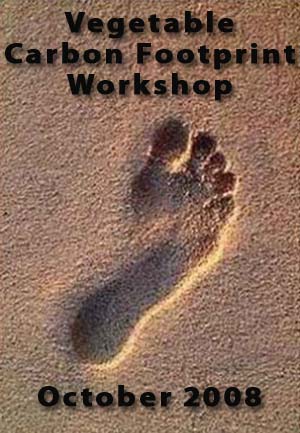|
This workshop brought together industry and researchers to gain agreement on the best approach and industry requirements for the development of a carbon footprinting tool for the Australian vegetable industry.
Government and community perceptions regarding industry emissions are moving fast, need to understand what consumers are focusing on in this area and how to respond.
This report summarises the outcomes of the workshop as well as the six discussion papers


Big picture issues :
- High profile issue with a lot of activity, especially Governments
- Reality that industry needs to understand the triple bottom line impact of the production / business.
- Even though horticulture (and therefore vegetable industry) is only a small proportion of the national emissions there is still a need to understand our contribution when talking to Government
- Rules of engagement of an Emissions Trading Scheme may change by 2015 so if industry is not aware and confident in their contribution then they will be worse off
- Cost efficiency and trade off of addressing business emissions needs to be determined to give growers a decision on how to implement any actions to reduce emissions.
- Profitability of growers is a major concern, so any recommended practice changes need to be cost effective
- Potential for efficiencies to bring benefits to growers?
- Eco-efficiency (broader approach to sustainability) is important
A footprinting tool for industry :
- Agreement that a tool would be nice to have, but not a requirement o Any tool needs to be simple and flexible and useful for measuring direct emissions from on-farm o Needs to be free and easily accessible
- Many tools are already available, but need to be adapted for industry. Need a simple interface, good emission factors validated by science and protocol that sits behind it
- Needs to integrate with existing systems and reporting o Focus on on-farm footprint, not greenhouse gas accounting (this is too specific, will be costly, and the industry is a minimum contributor to national emissions so there is no benefit in going to this accounting level)
- Need to consider the extension of the tool as well
Need for benchmarking :
- Benchmarking of the industry through footprinting will be important – allow for future industry planning, allow for comparison with other industries and potentially internationally
Public perception :
- Consumers will not pay for this, but will require it (premium versus expectation)
- Confirm industry ‘right to farm’ – can a footprint defend this?
- Increase community trust in sustainability of industry and its practices
- Education of consumers is important
Urgency for proactive response :
- Carbon footprinting has similarities with the Quality Assurance Scheme – there is a need to ensure that industry is well placed to proactively respond to this issue
Research needs :
- Need to refine and improve emissions factors, e.g. field study of N2O emissions for various vegetable crops
- Fill in gaps in data – Fuel use for machinery operations, irrigation requirement for various vegetable crops, electricity use for post-harvest storage, and fertiliser use
- Development of recognised protocol as well as footprinting interface
- Interpretation document and potential for extension of the tool needs to be scoped when developing the tool
- Education and awareness campaign for consumers interpretation of footprinting results
- Cost-benefit analysis of reduction options
- Benchmarking of current industry practice, in relation to practices that influence GHG emissions
- Investigation of soil carbon sequestration opportunities for industry.
Acknowledgments :
Funding was provided by Australian vegetable growers (through the R & D levy) and Horticulture Australia Limited. The Australian Government provides matched funding for all HAL’s R&D activities.
|

